After two long years of living through the Covid-19 pandemic and adapting to the “new normal,” consumers have become all too familiar with the effects of supply chain issues. From hospitals to supermarkets and everything in between, it has become increasingly obvious that no industry is fully insulated nor completely safe from the reaching effects of the Covid-19 pandemic. Yet even as buyers have come to expect longer waits at restaurants and higher prices for deliveries in the last two years, shortages in the automotive industry in particular have begun to cause unexpected hardships.
Pandemic related shortages hit the big manufacturers in the automotive industry first. Delayed shipments of necessary parts, worker shortages, and skittish consumers forced the major manufacturers to make cut-backs, leading to a shortage of new cars on the market. As the number of new cars on the market began to plummet, prices naturally started to rise according to the old market rules of supply and demand. Prices of new cars on the market have surged further and further each year of the pandemic, increasing by an average of $1800 per vehicle in 2019, over $3000 in 2020, and a whopping extra $6000 on top of that in 2021. By January of 2022 the average sticker price of a new car had risen to over $47,000.

These massive price hikes forced consumers to seek more affordable options in the used car market. The increase in demand for these vehicles predictably caused similar price spikes to take hold in that market as well. In the first year of the pandemic, the average price of a used car jumped 44% from about $17,500 to over $25,000. Additionally, the amount consumers saved on average by buying used instead of new has shrunk rapidly as the value of older cars increased. By January of 2022 the average price of a used vehicle had jumped up to 65% of the price of a brand new counterpart. While there are certainly still many used vehicles on the market being offered for far less than those median numbers, consumers still must remain wary of options that seem good up front but leave them on the hook for costly repairs to an aging vehicle later. Facing such devastating price hikes in the markets for both new and used vehicles, it’s no surprise that many potential buyers have opted to wait the market out and to hang on to whatever they’re currently driving for as long as possible.
Waiting for new and used car prices to fall back to pre-pandemic levels has seemingly become the best option for those who are able to keep their older vehicles running long enough to wait for the market to balance out. Fantastic as this idea may seem however, it is hardly a novel one, and the increased demand for keeping older vehicles in working condition has recently caused something of a run on the auto-repair market as well. Mechanics and auto-shops who were already suffering from some of the same supply issues as the big manufacturers (parts shortages, delivery delays, and worker shortages) are now being inundated by a flood of repair and maintenance requests from owners who would have otherwise have just moved on to a new vehicle.
As has happened with countless other industries already, the direct effects of the pandemic on supply and worker shortages have combined with the indirect effects of a huge surge in demand to bring the automotive repair industry to its knees. Recent surveys of automotive repair industries show that due to these shortages, consumers have nearly universally been forced to wait longer and pay more for the same routine services they had done before Covid. Even more frighteningly, some more specialized services have become nearly impossible to complete at all as repair shops wait endlessly for niche parts to be delivered. All of these factors have combined to make the goal of keeping an aging vehicle maintained something of a Herculean task for families already struggling with the innumerable other effects of the pandemic.
Like a proverbial swarm of locusts descending upon and devastating once ripe fields, consumers in the automotive marketplace have found the answers to individual supply chain issues and picked them clean one after another. Unmet demand for new cars turned buyers toward the used car market, and then unmet demands for both have forced consumers to overrun the repair and maintenance markets. The cascading effects of reduced supplies and increased demands throughout all corners of the automotive industry may seem inescapable at this point, leaving consumers with nowhere to turn. With the return of pre-pandemic automotive prices still likely years away in late 2023 or early 2024, the future may look bleak for consumers looking to find reliable wheels at anything resembling affordable prices.

Indeed, at first glance it does seem as though all hope for buying and maintaining a vehicle at a reasonable cost is a bygone dream of a pre-pandemic era. But all hope is not yet lost for those who wish to squeeze as much automotive power as possible out of their money. The answer to consumers’ woes during this time may just take some clever planning and combining of the resources still available on the strained automotive market.
As anyone who’s ever spent an evening holding a flashlight for a parent half buried in an engine block can attest, the best way to prevent small problems from growing into big, expensive problems is routine maintenance. Now that prices and wait times at auto shops are beginning to skyrocket and the individual parts required to fix many automotive issues are becoming increasingly scarce, routine maintenance has never been more important. A timely oil change or belt replacement now could save a vehicle from a blown head gasket or total engine failure later.
The key, of course, is in finding ways to get those routine repairs and maintenance procedures done while repair shops are as overwhelmed as they currently are. This is why clever consumers must find ways to set themselves apart from the masses being forced to submit to extended wait times and ever climbing price hikes for even the most routine services.
This is where extended free maintenance services like those currently being offered by Car Credit can be a complete game changer for buyers in the modern marketplace. Car Credit’s offer guarantees that they will handle all routine maintenance for the first two years after a used car is purchased. This kind of service offers to have the dealership take on the responsibilities of regular maintenance actions such as oil and filter changes, belt and brake pad replacements, tune ups and spark plug checks for the buyer. Maintenance agreements such as this one can help the modern consumer immensely by removing both the burden of finding an opening at overwhelmed repair shops, and the costly price tag of said services from their shoulders. With the prices of such crucial maintenance services only increasing as supply chain issues continue to wear on, offers like this one can be a hidden gold mine for thrifty consumers. In fact, at the rate that the costs of regular maintenance visits are increasing, such offers may even be twice as valuable in 2023 and 2024 as they are now.

The kind of maintenance that Car Credit’s offer guarantees can greatly extend the lifetime of an older vehicle. This can allow a consumer to purchase a used vehicle on the older side of the spectrum, and on the easier side of the checkbook, without fear that those savings will have to be poured out into repair costs later. The regular tune ups and engine checks can also help prevent the kind of nasty automotive surprises that would hurt during normal times and be absolutely devastating in the current market.
Though the issues facing the automotive sector are huge and interlinked from top to bottom, it is clear that there are still ways for resourceful consumers to find the deals that can get them what they want in cost effective ways. One such way is by looking into maintenance agreements such as those being offered by Car Credit, which effectively allow consumers to take the best parts from the used car and automotive repair markets, while dodging the negatives currently facing both markets. By cleverly combining the deals that can still be found in the used car market with programs that free the buyer from the trials and costs of the modern repair and maintenance markets, it is still possible for a consumer to get a reliable vehicle without breaking the bank in the supply chain issue riddled economy.
Original Author:
Garrison Rose
References Cited (In order of appearance):
- https://www.kbb.com/car-news/average-new-car-price-tops-47000/ (Kelley Blue Book)
- https://www.cars.com/articles/when-will-used-car-prices-drop-3-things-car-shoppers-should-know-446525/ (Cars.com)
- https://www.automotiveresearch.com/insights/effects-supply-chain-disruptions-automotive-repair-shops (IMR Automotive Research)
- https://www.caranddriver.com/news/a39357957/car-prices-high-when-will-change/ (Car and Driver)
- https://www.carcredittampa.com/limited-maintenance-agreement/ (Car Credit Tampa)


